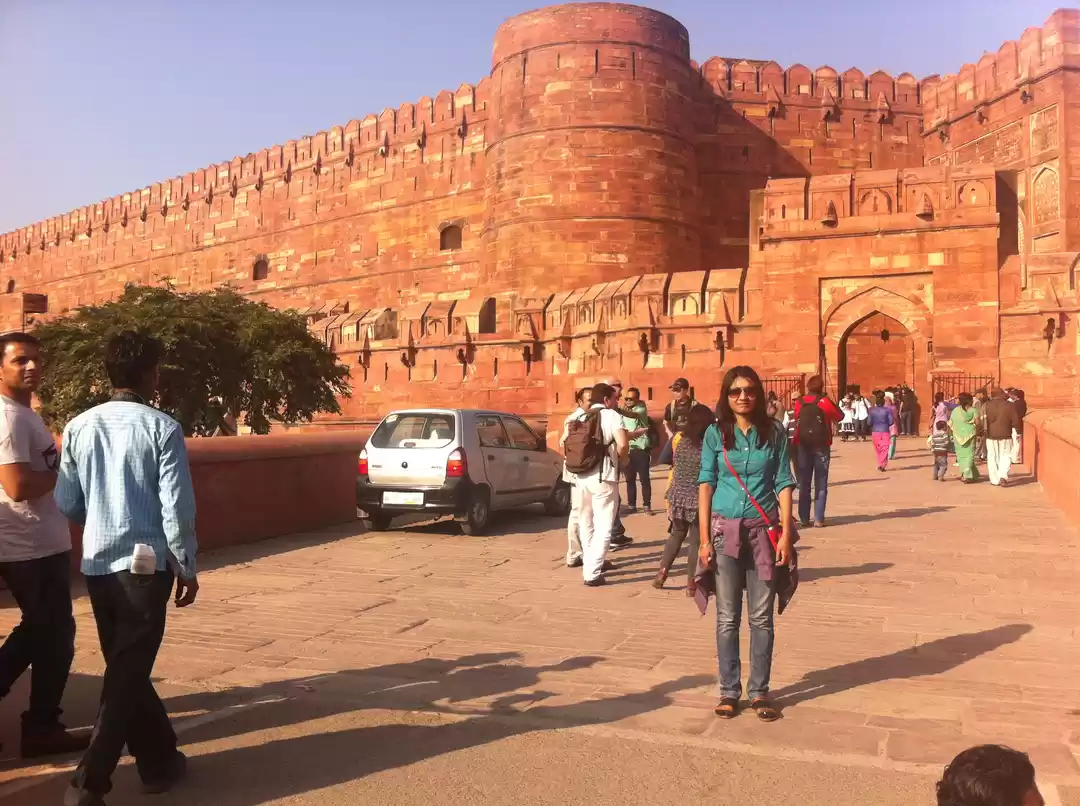On 10th November 21, morning at 8.30 we checked out hotel Safari and went by auto to Tajmahal (parked our car at hotel only). Autowala dropped us at West gate. After entering we hired a guide for Rs 300/- and took a electric car from West gate to main entrance of Tajmahal which charges Rs.10/- per person else you need to walk 0.5 km. At the drop point of the electric car there is a snacks point where we ate bread sandwiches and had tea and then entered Tajmahal, at this point you have to show your online tickets. Entry ticket is Rs.45/- and for visitors who want to visit main mausoleum have to buy extra ticket Rs 200/-. You have to buy tickets online only. children below 15 years have free entry. TahMahal remains closed on Fridays.
Tajmahal was commissioned in 1632 by the Mughal emperor Shah Jahan (reigned from 1628 to 1658) to house the tomb of his favourite wife, Mumtaz Mahal; it also houses the tomb of Shah Jahan himself.
TahMahal situated on the right bank of the river Yamuna in Agra, designated as a UNESCO World Heritage Site in 1983 for being "the jewel of Muslim art in India and one of the universally admired masterpieces of the world's heritage". It is regarded by many as the best example of Mughal architecture. The Taj Mahal attracts 7–8 million visitors a year and in 2007, it was declared a winner of the New 7 Wonders of the World (2000–2007) initiative. Tajmahal is magnificent but as we are exploring India from last 100 days and previously visited to Mt.Abu, we saw better marble work and stone crafting done in Rajasthan and in South India. But as TahMahal is signature of love, we loved it. It is a masterpiece. The tomb is made up entirely of ivory white marble and features jade, crystal, turquoise and amethyst stones inlaid throughout. Over 20,000 labourers worked about 22 years. Exploring Taj Mahal is a unique and awesome experience. The tomb is the centrepiece of a 17-hectare (42-acre) complex. We spent almost 2 hours at Tajmahal and then went to Agra Fort by auto. Here also you have to buy tickets online Rs. 35/- + 10/-. At least one hour is required for exploring Agra Fort. We hired a guide for Rs.250/-.
Agra Fort is a historical fort. It was the main residence of the emperors of the Mughal Dynasty. Two of the fort's gates are notable, the "Delhi Gate" and the "Lahore Gate." The Lahore Gate is also known as the "Amar Singh Gate," for Amar Singh Rathore. Before capture by the British, the last Indian rulers to have occupied it were the Marathas. In 1983, the Agra fort was life inscribed as a UNESCO World Heritage Site. It is about 2.5 km northwest of Tajmahal. Agra Fort is open from sunrise to sunset every day. This formidable fortress rests on the west bank of the Yamuna River on the edge of central Agra. Agra Fort boasts impressive red sandstone architectural details throughout and is considered as one of the best Mughal forts in India. It’s wonderful place and reminds us about our history. Specially reminded Chatrapati Shivaji Maharaj when we entered in Agra Fort. In the court of the fort, on 12 May 1666, Aurangzeb made Shivaji Maharaj stand behind mansabdars (military commanders) of his court. Shivaji Maharaj took offence and stormed out of court and was promptly placed under house arrest. It is well known that later he managed his escape from Agra Fort.
We can easily see Taj Mahal from the terrace of this fort. Also there is a Takht-e-Jahangir ( Throne of Jahangir) made up of black Stone imported from Belgium by Jahangir. This fort was built by emperor Akbar, completed by Shah Jahan who was imprisoned in the same fort by his son Aurangjeb. In fort there are Shah Burj, Zharokha, Diwan-i-Khas, Shish Mahal, Khas Mahal, Bathtub of Jahangir, Jahangir Palace etc. After visiting Agra Fort we had lunch and then checked in hotel Radisson, Agra.

































